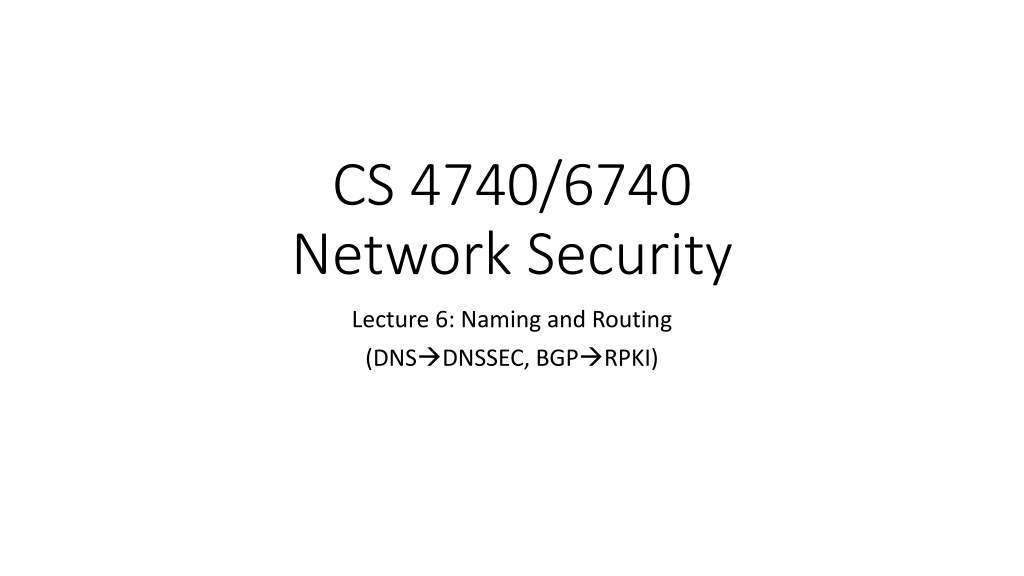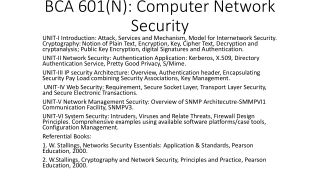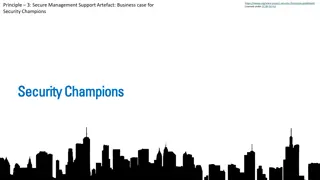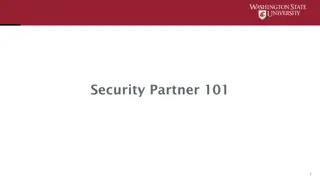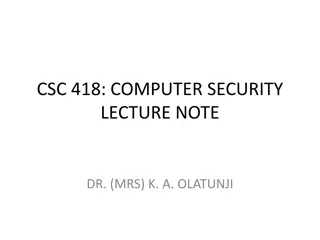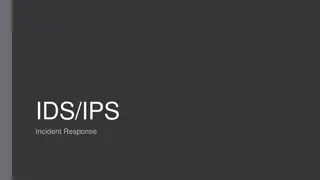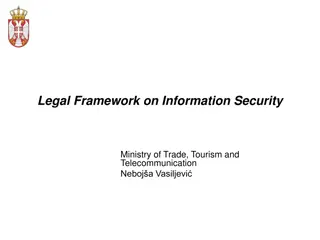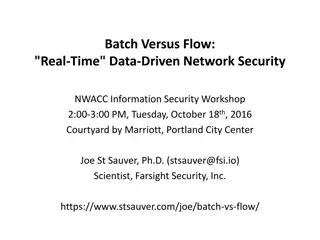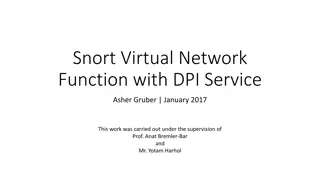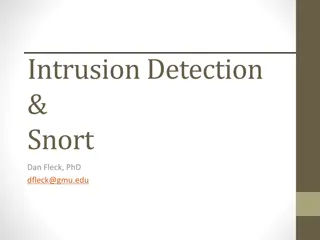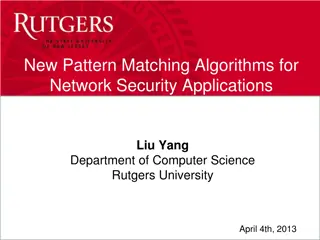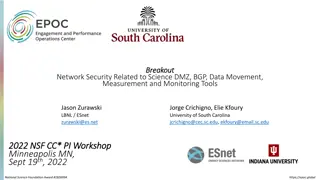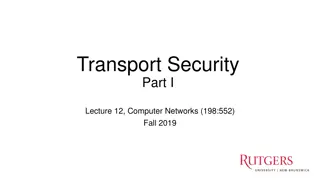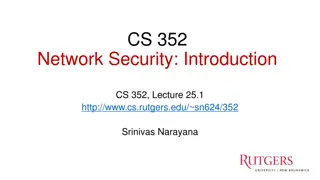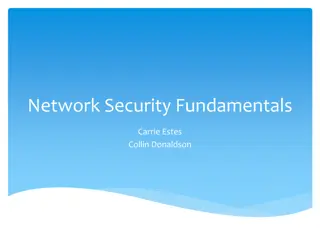Understanding Network Security Fundamentals
Explore the critical components of network security focusing on DNS, BGP, and RPKI. Learn about the importance of trust on the Internet, potential attacks, and measures to secure DNS and BGP protocols. Delve into naming hierarchy, DNS structure, hierarchical administration, and DNS server functions.
Download Presentation

Please find below an Image/Link to download the presentation.
The content on the website is provided AS IS for your information and personal use only. It may not be sold, licensed, or shared on other websites without obtaining consent from the author. Download presentation by click this link. If you encounter any issues during the download, it is possible that the publisher has removed the file from their server.
E N D
Presentation Transcript
CS 4740/6740 Network Security Lecture 6: Naming and Routing (DNS DNSSEC, BGP RPKI)
Trust on the Internet http://www.bofa.com When you visit www.bofa.com you assume a few things The name www.bofa.com will resolve to the correct IP of BofA s server Packets sent to BofA s IP will be successfully delivered to the right machine Technology underlies these assumptions DNS binds names to IP addresses BGP distributes the routes necessary to reach all IPs on the Internet If these assumptions are violated, an attacker can wreak havoc
Todays Topics DNS What is it, why do we need it, and why is it a security-critical service? Three attacks: injection, spoofing, and Kaminsky Securing DNS with DNSSEC BGP What is it, why do we need it, and why is it a security critical service? BGP hijacking S-BGP and why it failed Securing BGP with RPKI
DNS Authorities and Records Cache Poisoning DNSSEC
DNS at a High-Level Domain Name System Distributed database No centralization Simple client/server architecture UDP port 53, some implementations also use TCP Hierarchical namespace As opposed to original, flat namespace e.g. .com google.com mail.google.com
Naming Hierarchy Root net edu com gov mil org uk fr etc. Top Level Domains (TLDs) are at the top Each Domain Name is a subtree .edu neu.edu ccs.neu.edu www.ccs.neu.edu Maximum tree depth: 128 Name collisions are avoided neu.com vs. neu.edu neu mit ccs ece husky www login mail
Hierarchical Administration Root ICANN Verisign net edu com gov mil org uk fr etc. neu mit Tree is divided into zones Each zone has an administrator Responsible for the part of the hierarchy Example: CCIS controls *.ccs.neu.edu NEU controls *.neu.edu ccs www login mail
Server Hierarchy Functions of each DNS server: Authority over a portion of the hierarchy No need to store all DNS names Store all the records for hosts/domains in its zone May be replicated for robustness Know the addresses of the root servers Resolve queries for unknown names Root servers know about all TLDs The buck stops at the root servers
Root Name Servers Responsible for the Root Zone File Lists the TLDs and who controls them ~272KB in size com. 172800 IN NS a.gtld-servers.net. com. 172800 IN NS b.gtld-servers.net. com. 172800 IN NS c.gtld-servers.net. Administered by ICANN 13 root servers, labeled A M 6 are anycasted, i.e. they are globally replicated Contacted when names cannot be resolved In practice, most systems cache this information
Local Nameserver and Authorities www.google.com Where is www.google.com? Local nameserver Authority for *google.com Local nameserver handles queries on behalf of clients Authoritative nameservers know the zone mappings for a subset of the heirarchy ns1.google.com asgard.ccs.neu.edu Authority for *.com com Root nameserver Root
Basic Domain Name Resolution Every host knows and sends queries to a local nameserver If the local nameserver can answer the query, then you re done 1. Nameserver is also the authoritative server for that name 2. Nameserver has cached the record for that name Otherwise, go down the hierarchy and search for the authoritative name server Every local nameserver knows the root servers Use cache to skip steps if possible e.g. skip the root and go directly to .edu if the .edu zone file is cached
Iterated DNS query www.google.com Where is www.google.com? ns1.google.com asgard.ccs.neu.edu Contact server replies with the name of the next authority in the hierarchy I don t know this name, but this other server might com Root
DNS Resource Records DNS queries have two fields: name and type Resource record is the response to a query Four fields: (name, value, type, TTL) There may be multiple records returned for one query What are do the name and value mean? Depends on the type of query and response
DNS Types Query Name: www.ccs.neu.edu Type: A Type = A / AAAA Name = domain name Value = IP address A is IPv4, AAAA is IPv6 Resp. Name: www.ccs.neu.edu Value: 129.10.116.81 Type = NS Name = partial domain Value = name of DNS server for this domain Go send your query to this other server Query Name: ccs.neu.edu Type: NS Resp. Name: ccs.neu.edu Value: 129.10.116.51
DNS Types, Continued Query Name: foo.mysite.com Type: CNAME Type = CNAME Name = hostname Value = canonical hostname Useful for aliasing Resp. Name: foo.mysite.com Value: bar.mysite.com Type = MX Name = domain in email address Value = canonical name of mail server Query Name: ccs.neu.edu Type: MX Resp. Name: ccs.neu.edu Value: amber.ccs.neu.edu
DNS Packet Format Query/response? Authoritative/non-authoritative response? Success/failure? ID number used to match requests and responses 0 16 32 TxID Flags How many records are there of each type in the response payload? Question Count Answer Count Authority Count Additional Record Count Question and answer data (Resource Records, variable length) DNS is a UDP-based protocol on port 53 No TCP means no connections TxIDs are needed to correlate requests and responses Serves as authentication for responses
Glue Records DNS responses may contain more than a single answer Example: resolving cyclic dependency TxID: 5678 TxID: 5678 Q: 1 A: 0 Q: 1 A: 0 Auth: 1 Addl: 1 Auth: 0 Addl: 0 Q: Where is www.google.com? Q: Where is www.google.com? Auth: NS a.gtld-server.com asgard.ccs.neu.edu Root Addl: A a.gtld-server.com 12.56.10.1 Known as glue records Additional responses can contain any type of record (i.e. A, NS, etc.)
DNS Query, Revisited www.google.com Where is www.google.com? TxID: 12347 Q: 1 A: 1 TxID: 12345 TxID: 12346 TxID: 12347 Auth: 0 Addl: 0 Q: 1 Q: 1 Q: 1 A: 0 A: 0 A: 0 Q: Where is www.google.com? Auth: 0 Auth: 0 Auth: 0 Addl: 0 Addl: 0 Addl: 0 A www.google.com 182.0.7.34 Q: Where is www.google.com? Q: Where is www.google.com? Q: Where is www.google.com? ns1.google.com asgard.ccs.neu.edu TxID: 12346 TxID: 12345 Q: 1 A: 0 Q: 1 A: 0 Auth: 1 Addl: 1 Auth: 1 Addl: 1 a.gtld-server.com Q: Where is www.google.com? Q: Where is www.google.com? Auth: NS ns1.google.com Auth: NS a.gtld-server.com Root Addl: A ns1.google.com 8.8.0.1 Addl: A a.gtld-server.com 12.56.10.1
Attacking DNS Three types of attacks Old school attack: record injection Somewhat old school attack: response spoofing New, deadly attack: The Kaminsky Attack
Threat Model and Attacker Goals Where is www.bofa.com? Honest DNS Servers Local Active attacker, may send DNS packets Remote attacker, may not eavesdrop Attacker may control their own domains and DNS servers Nameserver I want to add a record to that DNS server that directs www.bofa.com 6.6.6.6 102.32.0.1 6.6.6.6
Record Injection Local Honest DNS Servers Nameserver Where is www.bofa.com? TxID: 12346 Q: 1 A: 1 Auth: 0 Addl: 1 Q: Where is www.attacker.net? A www.attacker.net 128.1.2.0 Addl: A www.bofa.com 6.6.6.6 Where is www.attacker.net? ns.attacker.net 102.32.0.1 6.6.6.6
Bailiwick Checking Record injection attacks no longer work in practice All modern DNS servers implement bailiwick checking Only records related to the requested domain are accepted in responses In other words, DNS servers are less trusting of additional information
Response Spoofing Local Honest DNS Servers Nameserver Where is www.bofa.com? TxID: 12347 Q: 1 A: 0 Auth: 0 Addl: 0 Q: Where is www.bofa.com? TxID: ???? Q: 1 A: 1 Auth: 0 Addl: 1 Q: Where is www.bofa.com A www.bofa.com 6.6.6.6 102.32.0.1 6.6.6.6
Implementing Response Spoofing What info does the attacker need to spoof a DNS response? IP address of the target nameserver and true authoritative nameserver Easy, both pieces of info are readily available Source port used by the authoritative nameserver Easy, it must be 53 The question in the query Easy, the attacker can choose the targeted domain name Response port used by the target when they made the request TxID in the query Old DNS servers used one port for all queries and incremented TxID monotonically Attacker can query the target DNS server for a domain they control and observe the query at their own DNS server The query reveals the port used by the target, as well as the approximate TxID
Inspecting the Target Local Honest DNS Servers Nameserver TxID: 12347 Q: 1 A: 0 Auth: 0 Addl: 0 Q: Where is www.bofa.com? Where is www.attacker.net? ns.attacker.net 102.32.0.1 6.6.6.6
Challenges of Response Spoofing Attacker must infer the response port of the target nameserver and TxID Attacker s response must outrace the legitimate response The attack must be executed after the target nameserver is queried for a domain that is not in the cache If the target domain name is already cached, no queries will be sent The attacker can send the initial query to the nameserver, but if the attack fails the legitimate response will be cached until the TTL expires If the attack is successful, the record for a single domain is poisoned
Kaminsky Attack Variation of the response spoofing attack that is much more powerful Discovered by notable security researcher Dan Kaminsky in 2008 Poisons glue records rather than A records Attacker repeatedly makes queries for non-existent subdomains of the target domain Since these subdomains do not exist, they are guaranteed to not be in the target nameservers cache Attacker then attempts to spoof a response with a poison glue record The attacker can attempt the attack an infinite number of times until success On success, entire zone is poisoned, rather than a single domain name
Kaminsky Attack Local Honest DNS Servers Nameserver Where is www.bofa.com? Where is aaaa.bofa.com? aaab.bofa.com? Where is TxID: ???? TxID: ???? Q: 1 Q: 1 A: 1 A: 1 Auth: 1 Auth: 1 Addl: 1 Addl: 1 Q: Where is aaaa.bofa.com Q: Where is aaab.bofa.com A: aaaa.bofa.com = 127.0.0.1 A aaab.bofa.com 127.0.0.1 Auth: NS = ns1.bofa.com Auth: NS ns1.bofa.com ns.attacker.net 6.6.6.8 Addl: ns1.bofa.com = 6.6.6.8 Addl: A ns1.bofa.com 6.6.6.8 102.32.0.1 6.6.6.6
Mitigating the Kaminsky Attack The Kaminsky attack relies on fundamental properties of the DNS protocols Specifically, the ability to repond with NS records and glue to any query The functionality is essential for DNS, it cannot be disabled How do you mitigate the Kaminsky attack? Make it harder to spoof DNS responses All modern DNS servers randomize the TxID and query port for every request 216 TxIDs * 232 query ports = 248 messages needed to spoof successfully Despite this mitigation, almost all existing DNS servers are still fundamentally vulnerable to spoofing attacks
Additional DNS Hijacks Infect the target user s OS or browser with a virus/trojan e.g. Many trojans change entries in /etc/hosts *.bankofamerica.com evilbank.com Man-in-the-middle DNS is not encrypted or strongly authenticated
Authentication for DNS Domain Name System Security Extensions (DNSSEC) Integrates a public key infrastructure (PKI) into DNS Provides end-to-end authentication and integrity, but not confidentiality Prevents DNS hijacking! But, complex to deploy, some performance overhead, much power given to DNS root Deployment On the roots since July 2010 Verisign enabled it on .com and .net in January 2011 Comcast is the first major ISP to support it (January 2012)
DNSSEC Details Cryptographically sign critical resource records Resolver can verify the cryptographic signature Four new resource types DNSKEY Public key for a zone Signed by the private key of the parent zone Signatures from the root servers are trusted by default DS Delegated signer RRSIG Digital signature of a specific resource record Signed by the private key of the zone NSEC* Signed denial of record existence Creates a hierarchy of trust within each zone Prevents hijacking and spoofing
DNSSEC Example www.google.com Where is www.google.com? A www.google.com 128.1.0.4 DNSKEY PGoogle RRSIG {H(A Record)}SGoogle Q: Where is www.google.com? ns1.google.com asgard.ccs.neu.edu NS ns1.google.com A ns1.google.com 8.8.0.2 DS google.com DNSKEY Pcom NS a.gtld-server.com A a.gtld-server.com 143.7.0.1 DS com DNSKEY PRoot a.gtld-server.com Root
BGP ASs and Announcement BGP Hijacking S-BGP and RPKI
Network Layer, Control Plane Function: Set up routes between networks Key challenges: Implementing provider policies Creating stable paths Data Plane Application Presentation Session Transport Network Data Link Physical Control Plane RIP OSPF BGP
BGP Border Gateway Protocol De facto inter-domain protocol of the Internet Policy based routing protocol Uses a Bellman-Ford path vector protocol Relatively simple protocol, but Complex, manual configuration Policies driven by economics How much $$$ does it cost to route along a given path? Not by performance (e.g. shortest paths) Entire world sees advertisements Errors can screw up traffic globally No authentication of announcements :(
Path Vector Protocol AS-path: sequence of ASs a route traverses Like distance vector, plus additional information Used for loop detection and to apply policy Default choice: route with fewest # of ASs AS 4 120.10.0.0/16 AS 3 130.10.0.0/16 AS 5 AS 2 110.10.0.0/16 120.10.0.0/16: AS 2 AS 3 AS 4 130.10.0.0/16: AS 2 AS 3 110.10.0.0/16: AS 2 AS 5 AS 1
BGP Operations (Simplified) Establish session on TCP port 179 AS-1 Exchange active routes AS-2 Exchange incremental updates
Four Types of BGP Messages Open: Establish a peering session. Keep Alive: Handshake at regular intervals. Notification: Shuts down a peering session. Update: Announce new routes or withdraw previously announced routes. announcement = IP prefix + attributes values
BGP Attributes Attributes used to select best path LocalPREF Local preference policy to choose most preferred route Overrides default fewest AS behavior Multi-exit Discriminator (MED) Specifies path for external traffic destined for an internal network Chooses peering point for your network Import Rules What route advertisements do I accept? Export Rules Which routes do I forward to whom?
Route Selection Summary Highest Local Preference Enforce relationships Shortest AS Path Lowest MED Traffic engineering Lowest IGP Cost to BGP Egress When all else fails, break ties Lowest Router ID
Shortest AS Path != Shortest Path 9 hops 2 ASs 4 hops 4 ASs Source Destination 43
Hot Potato Routing 5 hops total, 2 hops cost Source 3 hops total, 3 hops cost Destination 44
Importing Routes From Provider ISP Routes From Peer From Peer From Customer 45
Exporting Routes $$$ generating routes Customer and ISP routes only To Provider To Peer To Peer To Customer Customers get all routes 46
Other BGP Attributes AS_SET Instead of a single AS appearing at a slot, it s a set of Ases Why? Communities Arbitrary number that is used by neighbors for routing decisions Export this route only in Europe Do not export to your peers Usually stripped after first interdomain hop Why? Prepending Lengthening the route by adding multiple instances of ASN Why? 47
BGP Authentication How are BGP sessions authenticated? Shared secrets BGP relies on transitive trust You trust your neighbor s routers Your neighbor trusts some other routers Etc. Are there any guarantees that: An advertised route is "real"? Advertised routes aren't tampered with when forwarded? No. Manually configured shared secrets between routers AS-1 AS-2
AS 7007 Incident Famous incident in 1997 where AS 7007 announced its internal routing table to the world Very specific (/24) routes caused many ASes to route traffic through AS 7007, creating routing black holes
